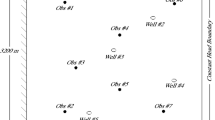Abstract
The observed hydrogeochemical condition of groundwater at a particular well is usually represented as a mixture of various sources of pollution and background conditions and is given in terms of measurements of multiple dissolved inorganic water contaminants such as total dissolved solids (TDS). Concentrations from a given set of wells can be compared against one another in a variety of ways, but the consideration as to which chemical concentrations are best related to one another is limited. In this analysis, an example is given to show that if there are a total of N concentration values, all N must be considered simultaneously in order to ascertain whether the observed conditions at the well can be explained as a mixture, and this can be done by solving a quadratic programming problem-convex hull.
Résumé
L’état hydrogéochimique des eaux souterraines observé au droit d’un puits particulier est usuellement représenté comme un mélange de diverses sources de pollutions et de bruits de fond et est donné en terme de mesures de plusieurs contaminants inorganiques dissous, comme les solides totaux dissous par exemple (STD). Les concentrations issues d’un groupe de puits peuvent être comparées entre elles de différentes manières, mais le souhait de corréler au mieux telle concentration chimique avec une autre est limité. Dans cette étude, l’exemple traité montre que s’il existe un nombre total N de valeurs de concentration, ces Nvaleurs doivent être considérées simultanément afin de déterminer si les conditions observées au puits peuvent s’expliquer en terme de mélange ; ceci peut être réalisé en résolvant un problème quadratique programmable-une enveloppe convexe.
Resumen
La condición hidrogeoquímica observada en un pozo particular es generalmente resultante de la mezcla de varias fuentes de contaminación y las condiciones antecedentes y se traduce en términos de medidas de múltiples contaminantes inorgánicos disueltos tal como los sólidos totales disueltos (STD). Las concentraciones de un conjunto de pozos pueden ser comparadas unas contra otras por una variedad de métodos pero la consideración de las concentraciones químicas que mejor se relacionan es limitada. En este análisis se introduce un ejemplo que muestra que si existe un total de N valores de concentración, todos los N deben ser considerados simultáneamente a fin de establecer si las condiciones observadas en el pozo pueden ser explicadas como una mezcla. Esto se realizada por resolución de un problema cuadrático de envolvente convexa.




Similar content being viewed by others
References
Bazaraa MS, Sherali H, Shetty C (1993) Nonlinear programming, 2nd edn. Wiley-Interscience, New York
Dominico PA, Schwartz FW (1998) Physical and chemical hydrogeology, 2nd edn. Wiley, New York
Fetter CW (2001) Applied hydrogeology, Prentice-Hall, Englewood Cliffs, New Jersey
Peressini AL, Sullivan FE, Uhl JJ Jr (1991) The mathematics of nonlinear programming. Springer, Heidelberg Berlin New York
Author information
Authors and Affiliations
Corresponding author
Rights and permissions
About this article
Cite this article
Laton, W.R., Whitley, R.J. & Hromadka, T.V. A new mathematical technique for identifying potential sources of groundwater contamination. Hydrogeol J 15, 333–338 (2007). https://doi.org/10.1007/s10040-006-0106-4
Received:
Accepted:
Published:
Issue Date:
DOI: https://doi.org/10.1007/s10040-006-0106-4




